
|
Astronomy Picture Of the Day (APOD)
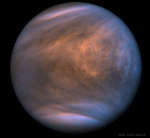 Biomarker Phosphine Discovered in the Atmosphere of Venus
Biomarker Phosphine Discovered in the Atmosphere of Venus
15.09.2020
Could there be life floating in the atmosphere of Venus? Although Earth's planetary neighbor has a surface considered too extreme for any known lifeform, Venus' upper atmosphere may be sufficiently mild for tiny airborne microbes. This usually disfavored prospect took an unexpected upturn yesterday with the announcement of the discovery of Venusian phosphine.
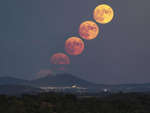 Corn Moon Rising
Corn Moon Rising
14.09.2020
A rising moon can be a dramatic sight. A rising Full Corn Moon was captured early this month in time-lapse with a telephoto lens from nearly 30 kilometers away -- making Earth's ascending half-degree companion appear unusually impressive.
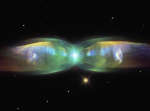 M2 9: Wings of a Butterfly Nebula
M2 9: Wings of a Butterfly Nebula
13.09.2020
Are stars better appreciated for their art after they die? Actually, stars usually create their most artistic displays as they die. In the case of low-mass stars like our Sun and M2-9 pictured here, the stars transform themselves from normal stars to white dwarfs by casting off their outer gaseous envelopes.
 A Thousand Meteors
A Thousand Meteors
12.09.2020
Over a thousand meteors flash through the night in this intriguing timelapse video. Starting in April 2019 the individual video frames were selected from 372 relatively clear nights of imaging from an automated wide-field observatory in rural New South Wales Australia.
 The Reappearance of Mars
The Reappearance of Mars
11.09.2020
Mars reappears just beyond the Moon's dark limb in this stack of sharp video frames captured on September 6. Of course to reappear it had to disappear in the first place.
 Jupiter s Swimming Storm
Jupiter s Swimming Storm
10.09.2020
A bright storm head with a long turbulent wake swims across Jupiter in these sharp telescopic images of the Solar System's ruling gas giant. Captured on August 26, 28, and September 1 (left to right) the storm approximately doubles in length during that period.
 Pleiades: The Seven Sisters Star Cluster
Pleiades: The Seven Sisters Star Cluster
9.09.2020
Have you ever seen the Pleiades star cluster? Even if you have, you probably have never seen it as large and clear as this. Perhaps the most famous star cluster on the sky, the bright stars of the Pleiades can be seen without binoculars from even the depths of a light-polluted city.
 GW190521: Unexpected Black Holes Collide
GW190521: Unexpected Black Holes Collide
8.09.2020
How do black holes like this form? The two black holes that spiraled together to produce the gravitational wave event GW190521 were not only the most massive black holes ever seen by LIGO and VIRGO so far, their masses -- 66 and 85 solar masses -- were unprecedented and unexpected.
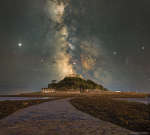 The Milky Way over St Michaels Mount
The Milky Way over St Michaels Mount
7.09.2020
Where do land and sky converge? On every horizon -- but in this case the path on the ground leads to St Michael's Mount (Cornish: Karrek Loos yn Koos), a small historic island in Cornwall, England. The Mount is usually surrounded by shallow water, but at low tide is spanned by a human-constructed causeway.
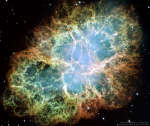 M1: The Crab Nebula from Hubble
M1: The Crab Nebula from Hubble
6.09.2020
This is the mess that is left when a star explodes. The Crab Nebula, the result of a supernova seen in 1054 AD, is filled with mysterious filaments. The filaments are not only tremendously...
|
January February March April May June July August September October November December |
||||||||||||||||||||||||||||||||||||||||||||||||||||||||